|
Snapshots 31-45
-t.JPG)
John
Lewis, an antique dealer in Homerville/Dupont, Georgia, has a number of kettles and
cane mills, which included this Columbus Iron Works two-roller mill (Slide
31) in Dupont that was subsequently purchased by Tommy Clayton.. Columbus Iron Works made a number of two-roller
mills that corresponded approximately by number and
capacity with the 2-roller mills made by Goldens' Machine
and Foundry. An interesting aspect of this mill, pointed
out by Don Dean (who owns a similar mill), is that the roller spacing was adjusted
by driving wooden wedges behind the bearing box. Note,
therefore, the opening in the top plate by the bearing
box. (As a disclaimer, I note that my mentioning a dealer does not imply endorsement.)
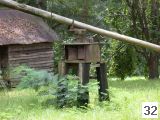 The
former importance of the sugar-cane industry in south
Georgia and north Florida is attested to by the range of makes and models of mills that still
dot the landscape. This mill (Slide
32), near Metcalfe, Georgia, is a type that I had not
seen before. As the mill was located on private property,
I was unable to examine it. (Thanks
to Ken Womble for pointing the mill out to me.) The
former importance of the sugar-cane industry in south
Georgia and north Florida is attested to by the range of makes and models of mills that still
dot the landscape. This mill (Slide
32), near Metcalfe, Georgia, is a type that I had not
seen before. As the mill was located on private property,
I was unable to examine it. (Thanks
to Ken Womble for pointing the mill out to me.)
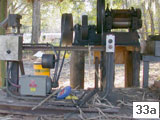 It was a pleasure to meet Thomas Duggar (Bristol, Florida) in
his barbershop, where he sells his cane syrup (too inexpensively,
in my opinion). Thomas’ operation, just behind his shop, is
based on a Goldens' No. 27 (New Model) (Slide
33a), which he built from parts of two mills.
It was a pleasure to meet Thomas Duggar (Bristol, Florida) in
his barbershop, where he sells his cane syrup (too inexpensively,
in my opinion). Thomas’ operation, just behind his shop, is
based on a Goldens' No. 27 (New Model) (Slide
33a), which he built from parts of two mills. 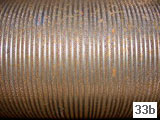 Note
that this mill is run directly--no speed reducer--by a 5-HP
electric motor that is connected to the mill by two narrow belts.
The rollers on this mill had been worn or turned down so much
that juice could not be expressed efficiently. As a remedy,
a textured brass sleeve (Slide
33b) was installed over the roller , which works well according
to Thomas. Note
that this mill is run directly--no speed reducer--by a 5-HP
electric motor that is connected to the mill by two narrow belts.
The rollers on this mill had been worn or turned down so much
that juice could not be expressed efficiently. As a remedy,
a textured brass sleeve (Slide
33b) was installed over the roller , which works well according
to Thomas.
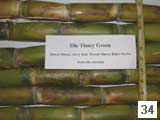 Melvin
Blount and the gang (Nashville, Georgia) grow some of the most
beautiful cane, mostly a purplish cultivar, that I have seen.
One year, they grew this green cultivar and referred to it as Old Timey Green (Slide
34); Don
Dean also calls it Georgia Green. It seems to be known in the earlier English literature as Green, Home Green, Otaheite, and Bourbon, and in the Spanish literature as Cana Blanca. Most of the people who
have grown this cane agree that it does not come back from the
stubble well and always note the cactus-like thorns. It is reported
to make good syrup--as I confirmed on my stovetop--however, and the juice content is very satisfying--I
cut a 4-foot section; it weighed 5.5 pounds and yielded just
shy of 1.5 quarts of juice. Given a roller-surface-speed of
27 feet per minute (recommended for power mills), this rate
of juice expression per line of stalk exceeds 150 gallons per
hour! Melvin
Blount and the gang (Nashville, Georgia) grow some of the most
beautiful cane, mostly a purplish cultivar, that I have seen.
One year, they grew this green cultivar and referred to it as Old Timey Green (Slide
34); Don
Dean also calls it Georgia Green. It seems to be known in the earlier English literature as Green, Home Green, Otaheite, and Bourbon, and in the Spanish literature as Cana Blanca. Most of the people who
have grown this cane agree that it does not come back from the
stubble well and always note the cactus-like thorns. It is reported
to make good syrup--as I confirmed on my stovetop--however, and the juice content is very satisfying--I
cut a 4-foot section; it weighed 5.5 pounds and yielded just
shy of 1.5 quarts of juice. Given a roller-surface-speed of
27 feet per minute (recommended for power mills), this rate
of juice expression per line of stalk exceeds 150 gallons per
hour!
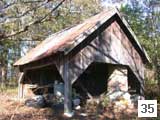 Friends
Harvey Bledsoe and Raleigh Player, both deceased, made syrup
under this picturesque syrup shed (Slide
35) near Inwinville (Georgia) with juice expressed on a
Goldens' No.27 (New Model), which was nearby. Irwinville is, of course, better
known as the site where President Davis was taken into custody
by the invading armies. Irwinville sets between Fitzgerald and
Waterloo and nothing more needs to be said. (Thanks to Dale
Bledsoe, Harvey's son, for showing me this syrup operation;
also, thanks to Terry Hester, a relative, for information.) Friends
Harvey Bledsoe and Raleigh Player, both deceased, made syrup
under this picturesque syrup shed (Slide
35) near Inwinville (Georgia) with juice expressed on a
Goldens' No.27 (New Model), which was nearby. Irwinville is, of course, better
known as the site where President Davis was taken into custody
by the invading armies. Irwinville sets between Fitzgerald and
Waterloo and nothing more needs to be said. (Thanks to Dale
Bledsoe, Harvey's son, for showing me this syrup operation;
also, thanks to Terry Hester, a relative, for information.)
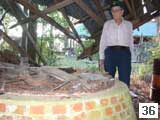 Parks
Gray (Slide
36), in 2003, was a prominent
builder in Tallahassee. Over the years, he lived in many homes,
products of his work, but finally settled on the family farm
on Springhill Road, just south of Tallahassee (Florida). Memories
run deep; a large oak in his backyard was planted by his late
brother in 1907. Parks made syrup with a power mill and this
furnace, which held a 100-gallon Goldens' kettle. Soon after this photograph was made, I disassembled the furnace and salvaged the brick. (Postscript: I note with sadness the passing of Mr. Gray on October 12, 2010, at age 96.) Parks
Gray (Slide
36), in 2003, was a prominent
builder in Tallahassee. Over the years, he lived in many homes,
products of his work, but finally settled on the family farm
on Springhill Road, just south of Tallahassee (Florida). Memories
run deep; a large oak in his backyard was planted by his late
brother in 1907. Parks made syrup with a power mill and this
furnace, which held a 100-gallon Goldens' kettle. Soon after this photograph was made, I disassembled the furnace and salvaged the brick. (Postscript: I note with sadness the passing of Mr. Gray on October 12, 2010, at age 96.)
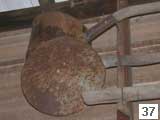 This
collection of syrup-making tools (Slide
37) was used by Eston Rowe (Nashville, Georgia). The Goldens'
No. 1 (New Model) still stands nearby and remains in nice shape.
The 50-gallon Kehoe kettle he used is under a nearby shed, but
unfortunately, like so many kettles, it is cracked. This
collection of syrup-making tools (Slide
37) was used by Eston Rowe (Nashville, Georgia). The Goldens'
No. 1 (New Model) still stands nearby and remains in nice shape.
The 50-gallon Kehoe kettle he used is under a nearby shed, but
unfortunately, like so many kettles, it is cracked.
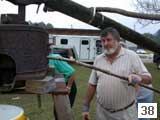 Billed
as "an old-fashioned sampling of southern heritage seasoned
with folk artisans, cane milling and railroad memorabilia,"
Williams Station Day (Atmore, Alabama) is mostly a local event.
Wilson Johnson, shown here feeding a 2-roller Goldens' mill (Slide
38) made most of his living in the timber business, and,
as I inferred, by trading in mules. Still, at one time, he had
a 100-gallon-a-day syrup operation. Billed
as "an old-fashioned sampling of southern heritage seasoned
with folk artisans, cane milling and railroad memorabilia,"
Williams Station Day (Atmore, Alabama) is mostly a local event.
Wilson Johnson, shown here feeding a 2-roller Goldens' mill (Slide
38) made most of his living in the timber business, and,
as I inferred, by trading in mules. Still, at one time, he had
a 100-gallon-a-day syrup operation.
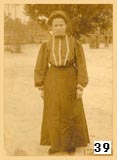 Jettie Brogdon Powell (Slide
39)--My, what an example of Southern Womanhood, a comment intended in the most respectful way. Modest, proper, engaged, elegant . . . . I have stared into her eyes so often and so long that I forget that this photo (undated) is 100 or more years old and that she has completed her mortal trials and was laid to rest at Riverside Baptist Church. I digress; the concern of Southern Matters is the cane mill and juice barrel on the right behind her. This set-up exemplifies, I imagine, the frameless mills that were used in the 1800s by syrupmakers in my home county (Berrien County, GA), which was less prosperous than many other areas. (Jettie's sister Kizzie Brogdon Cooper (b. 1881) married my grandfather L.G. Outlaw's first cousin Will Cooper, hence these photographs in our collection. Special thanks to Ken Christison, who restored the photograph of JBP, and to John Crawford, who restored the photograph of KBC. Thanks also to Gary M. Outlaw, who visited the graves with me at Riverside.) Jettie Brogdon Powell (Slide
39)--My, what an example of Southern Womanhood, a comment intended in the most respectful way. Modest, proper, engaged, elegant . . . . I have stared into her eyes so often and so long that I forget that this photo (undated) is 100 or more years old and that she has completed her mortal trials and was laid to rest at Riverside Baptist Church. I digress; the concern of Southern Matters is the cane mill and juice barrel on the right behind her. This set-up exemplifies, I imagine, the frameless mills that were used in the 1800s by syrupmakers in my home county (Berrien County, GA), which was less prosperous than many other areas. (Jettie's sister Kizzie Brogdon Cooper (b. 1881) married my grandfather L.G. Outlaw's first cousin Will Cooper, hence these photographs in our collection. Special thanks to Ken Christison, who restored the photograph of JBP, and to John Crawford, who restored the photograph of KBC. Thanks also to Gary M. Outlaw, who visited the graves with me at Riverside.)
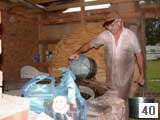 George
Connell (Quincy, Florida) is one tough old syrup maker! Working
in concert with Sonny Hudson, he is shown here dumping juice
(Slide 40)
expressed by his Chattanooga No. 14 into his Chattanooga 100-gallon
kettle. I must pay attention each time I see a Connell, as that
was the maiden name of my great-grandmother Susie Sutton. After
seeing George walk around over piles of this and that barefooted
and in the cold rain, I hope that we shared some genes, but,
if so, it is sadly distant. George
Connell (Quincy, Florida) is one tough old syrup maker! Working
in concert with Sonny Hudson, he is shown here dumping juice
(Slide 40)
expressed by his Chattanooga No. 14 into his Chattanooga 100-gallon
kettle. I must pay attention each time I see a Connell, as that
was the maiden name of my great-grandmother Susie Sutton. After
seeing George walk around over piles of this and that barefooted
and in the cold rain, I hope that we shared some genes, but,
if so, it is sadly distant.
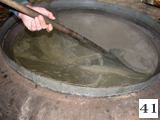 I speak with more than usual truthfulness when I say that I want to be only three places: home, the farm, or somewhere between the two. However, the Junior Museum in the south part of Tallahassee draws me. When I need solitude, the boardwalks through the cypress swamps provide the seclusion; when I seek amusement, the people attending cultural events provide it; when I am nostalgic, the cracker homestead provides the backdrop. In particular, a cane grinding and syrup making day takes place each fall. Homer Golden (who has a personal operation a couple of miles away) and his friends make a great team. Slide 41 shows one of them skimming the juice in this 80-gallon Waterford ( New York) kettle. I speak with more than usual truthfulness when I say that I want to be only three places: home, the farm, or somewhere between the two. However, the Junior Museum in the south part of Tallahassee draws me. When I need solitude, the boardwalks through the cypress swamps provide the seclusion; when I seek amusement, the people attending cultural events provide it; when I am nostalgic, the cracker homestead provides the backdrop. In particular, a cane grinding and syrup making day takes place each fall. Homer Golden (who has a personal operation a couple of miles away) and his friends make a great team. Slide 41 shows one of them skimming the juice in this 80-gallon Waterford ( New York) kettle.
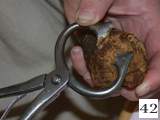 Before the age of white loose crystals of sugar, sugar nippers (Slide 42) were used to cut small amounts of sugar from a sugar cone. These particular nippers, part of an educational living display at the Acadian Village ( Lafayette, Louisiana), were reproductions from the “sutler” Jas. Townsend & Son. Before the age of white loose crystals of sugar, sugar nippers (Slide 42) were used to cut small amounts of sugar from a sugar cone. These particular nippers, part of an educational living display at the Acadian Village ( Lafayette, Louisiana), were reproductions from the “sutler” Jas. Townsend & Son.
 The Brinley-Hardy Co. (Louisville, Kentucky) manufactured cane strippers that were popular in South Georgia and North Florida. Slide 43 shows a scaled close-up of the metal end of a Brinley-Hardy stripper, which was mounted onto a handle. For other views of this stripper, click here, here, here, here, or here. The Brinley-Hardy Co. (Louisville, Kentucky) manufactured cane strippers that were popular in South Georgia and North Florida. Slide 43 shows a scaled close-up of the metal end of a Brinley-Hardy stripper, which was mounted onto a handle. For other views of this stripper, click here, here, here, here, or here.
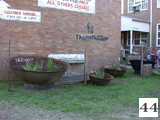 Syrup kettles are becoming popular decorative items, driving a demand for plastic ones as well as new, but authentic, ones as shown here at Washington (Louisiana) Old School House Antique Mall. These four sizes (Slide 44) range up to seven feet across and $1400. Syrup kettles are becoming popular decorative items, driving a demand for plastic ones as well as new, but authentic, ones as shown here at Washington (Louisiana) Old School House Antique Mall. These four sizes (Slide 44) range up to seven feet across and $1400.
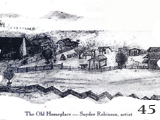 This South Georgia homestead (Slide 45) was drawn from memory to approximate its appearance in 1920 by the late Snyder Robinson. It features a double-pen log house with side rooms of lumber. Located between Nashville, Georgia, and Tifton, Georgia, it was the home place of Snyder’s father and mother, Rev. William David and Alice (nee Alexander) Robinson, and was earlier owned by Snyder’s grandparents, Milton and Melissa Robinson. Of particular relevance to our interest is the central location of the frameless cane mill (note sweep) and syrup-kettle shed. (Thanks to Aunt Bessie, Snyder’s sister, for the print from which I edited this image. Aunt Bessie, who was born in the house, married my father’s brother, Buren. After this place was sold, Reverend Robinson set up a nearby place. Uncle Buren’s family farmed with Rev. Robinson, and they first lived in a smaller adjacent home before moving into the big house to live with Mrs. Robinson after Rev. Robinson died. As long as I live, I hope not to loose my crystal-clear and cherished childhood memories of feather beds, slop jars, well water, the wood-burning stove, the food safe, the cattle gap, a mule that would attack one who spits, and much much more, all from my visits to the Robinson place. How could a young boy ever imagine the importance that these memories would take on fifty years later?) This South Georgia homestead (Slide 45) was drawn from memory to approximate its appearance in 1920 by the late Snyder Robinson. It features a double-pen log house with side rooms of lumber. Located between Nashville, Georgia, and Tifton, Georgia, it was the home place of Snyder’s father and mother, Rev. William David and Alice (nee Alexander) Robinson, and was earlier owned by Snyder’s grandparents, Milton and Melissa Robinson. Of particular relevance to our interest is the central location of the frameless cane mill (note sweep) and syrup-kettle shed. (Thanks to Aunt Bessie, Snyder’s sister, for the print from which I edited this image. Aunt Bessie, who was born in the house, married my father’s brother, Buren. After this place was sold, Reverend Robinson set up a nearby place. Uncle Buren’s family farmed with Rev. Robinson, and they first lived in a smaller adjacent home before moving into the big house to live with Mrs. Robinson after Rev. Robinson died. As long as I live, I hope not to loose my crystal-clear and cherished childhood memories of feather beds, slop jars, well water, the wood-burning stove, the food safe, the cattle gap, a mule that would attack one who spits, and much much more, all from my visits to the Robinson place. How could a young boy ever imagine the importance that these memories would take on fifty years later?)
|